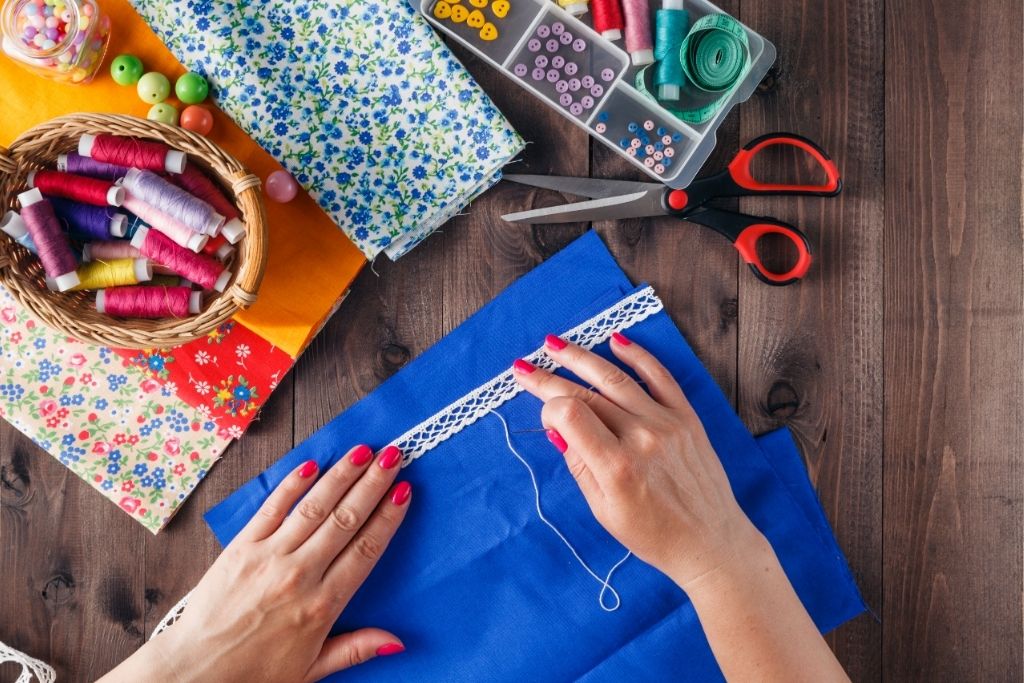When most people think of quilting, they imagine a little old lady sitting down and making blankets and sweaters.
This preconceived notion couldn’t be further from the truth, because folks, both young and old find quilting to be quite relaxing. Not to mention allows their creative juices to flow.
If you feel the same way, you may be missing out on a very therapeutic way to relieve stress and anxiety.
Anyone who says that a quilt is simply a patchwork is wrong, because behind every quilt is a story and behind every quilter is a storyteller.
You can’t become a skillful storytelling quilter overnight.
It takes time, patience, dedication, and most importantly; the willingness to learn the basics of quilting.
It’s usually not easy being a beginner in anything, because there’s a lot to learn and obstacles to overcome when things don’t go according to plan.
Your self-expectations will oftentimes be your most formidable enemy as a beginner quilter.
The best way to master the art of quilting is by taking baby steps, which means starting with the basics and then building upon those skills over time.
If you’ve been on the fence about taking up quilting as a hobby, then read these six tips to get a jumpstart…
1)) Learn Quilting Jargon and Terminology
Anytime you plan on mastering a subject, it’s critical that you become familiar with the terms used so that you can understand what’s being explained, which will allow you to connect the dots.
Just as a would-be physician studies medical terms, you have to learn every word that is associated with quilting.
Of course, you shouldn’t attempt to cram information about quilting, as that will only make you feel overwhelmed.
Keep in mind that quilting should be relaxing, even in the beginning stages.
When you encounter unfamiliar words as you read quilting literature and instructions, take the time to find out their meaning right on the spot.
If you know the jargon and terminology, you can better follow instructions and communicate with other quilters.
2)) Choose Simple Patterns
When you’re just getting started, it may be tempting to get your hands on the intricately designed patterns.
However, the problem is, they are often more complicated to work with.
I highly advise you to save them for future projects, after you’ve improved upon your skills.
When you’re first starting out, be realistic in assessing your skills.
It’s better to begin quilting with less complex patterns than to work on those that are advanced which can leave you exhausted and frustrated.
This frustration could cause you to give up on mastering the art of quilting, before creating a work of art that you’d be proud of.
3)) Begin With Less Complicated Projects
Again, be realistic, and choose smaller projects like pillowcases, placemats, or table runners and use them as experiments.
You are more likely to complete smaller projects because they’re less intimidating and don’t take as much time to get done.
As your skills advance, you can graduate to bigger and more complicated quilting projects.
4)) Decide Whether To Hand Quilt or Machine Quilt
Hand quilting is an old-school method of quilting and is preferred by many quilters, because of its traditional roots and recreational appeal.
It gives quilters more control over their projects, an avenue for socialization, especially if the quilt is done by a group of people, and a greater sense of accomplishment.
Machine quilting, on the other hand, is faster and easier to do and creates more identical and consistent stitches.
There may be times when you feel like hand quilting or machine quilting an entire project.
Other times, you may want to hand-quilt only a part; say the top, and then machine-stitch the rest.
It’s to your advantage to learn both methods because this provides you with a versatile skill set.
5)) Master Quilting Techniques
The heart of quilting is in piecing and stitching strips and layers of fabrics together.
Learning the different stitching techniques and styles is the foundation of mastering quilting.
Here’s a short list of quilting techniques:
- Block and Patchwork
- Measure and Sew Borders
- Piecing
- Basting
- Sew Seam Allowance (1/4 inch)
- Pressing Down Quilt Blocks
- Mitered Binding
- Rotary Cutting
The more you practice your craft, the better you’ll get in your quilting efforts.
6)) Avoid Being Too Critical
Remember, you are just starting on your quilting journey, and it is very likely that the stitches on your first few projects will be less than perfect.
Don’t stress over errors; instead, relax and enjoy the quilting process.
As you move from one project to the next, you will discover that your consistency and precision will develop, and you’ll begin picking up momentum.
As with anything, practice makes perfect. And before you know it, you’ll have mastered the basics of quilting.
Once the foundation has been laid, you’ll be ready to take on more complex projects, and eventually, make it to the expert level.
Conclusion
Quilting can be the perfect vehicle to help you get rid of stress and anxiety, but you have to give it a try first.
Let go of any preconceived notions that you may have by starting off with beginner-friendly projects, and then up your game by tackling those that are more complex.
Heck, if you suspect that those in your inner circle will make negative comments about your new hobby, then keep it to yourself, because this is your outlet, not theirs.
Quilting isn’t gender-specific, as there are both men and women who enjoy this relaxing hobby.
The only way to know whether or not you’d enjoy the art of quilting is by giving it an honest try for at least 60 days.
Good luck with your quilting projects!
Download Our Free E-book!







